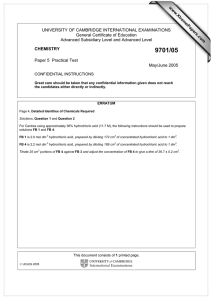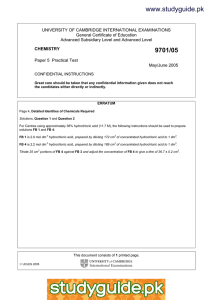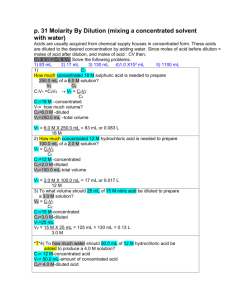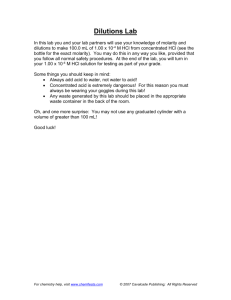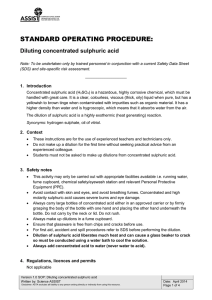Diluting concentrated hydrochloric acid
advertisement
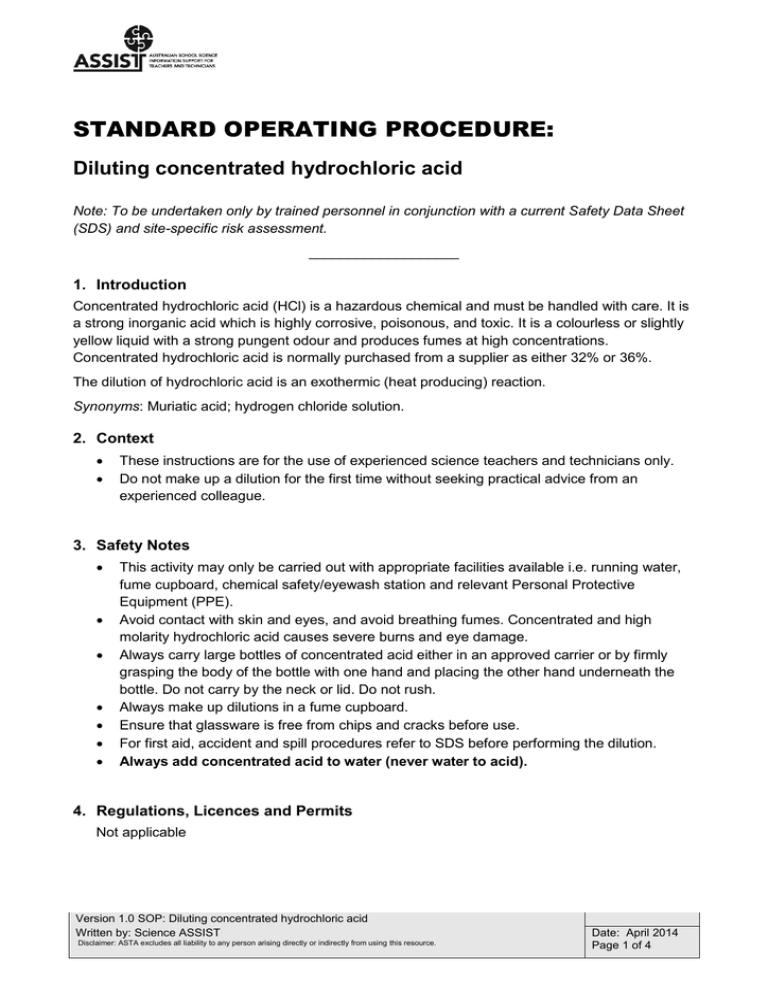
STANDARD OPERATING PROCEDURE: Diluting concentrated hydrochloric acid Note: To be undertaken only by trained personnel in conjunction with a current Safety Data Sheet (SDS) and site-specific risk assessment. ___________________ 1. Introduction Concentrated hydrochloric acid (HCl) is a hazardous chemical and must be handled with care. It is a strong inorganic acid which is highly corrosive, poisonous, and toxic. It is a colourless or slightly yellow liquid with a strong pungent odour and produces fumes at high concentrations. Concentrated hydrochloric acid is normally purchased from a supplier as either 32% or 36%. The dilution of hydrochloric acid is an exothermic (heat producing) reaction. Synonyms: Muriatic acid; hydrogen chloride solution. 2. Context These instructions are for the use of experienced science teachers and technicians only. Do not make up a dilution for the first time without seeking practical advice from an experienced colleague. 3. Safety Notes This activity may only be carried out with appropriate facilities available i.e. running water, fume cupboard, chemical safety/eyewash station and relevant Personal Protective Equipment (PPE). Avoid contact with skin and eyes, and avoid breathing fumes. Concentrated and high molarity hydrochloric acid causes severe burns and eye damage. Always carry large bottles of concentrated acid either in an approved carrier or by firmly grasping the body of the bottle with one hand and placing the other hand underneath the bottle. Do not carry by the neck or lid. Do not rush. Always make up dilutions in a fume cupboard. Ensure that glassware is free from chips and cracks before use. For first aid, accident and spill procedures refer to SDS before performing the dilution. Always add concentrated acid to water (never water to acid). 4. Regulations, Licences and Permits Not applicable Version 1.0 SOP: Diluting concentrated hydrochloric acid Written by: Science ASSIST Disclaimer: ASTA excludes all liability to any person arising directly or indirectly from using this resource. Date: April 2014 Page 1 of 4 5. Equipment Fume cupboard PPE (lab coat, safety glasses or face shield, acid resistant e.g. PVC or nitrile gloves, closed in shoes) Concentrated HCl Distilled/de-ionised water and wash bottle Large (2L) borosilicate glass beaker for diluting the acid Small glass measuring cylinder Large (1L) glass measuring cylinder or volumetric flask Glass stirring rod or magnetic stirrer and magnetic stirring bar Pre-labelled storage bottle Note: For laboratory `Stock’ solutions use measuring cylinders. For greater accuracy use volumetric flasks and pipettes. 6. Operating Procedure To make 1 litre of stock solution: 1. Wear PPE and work at a fume cupboard. 2. Into the large beaker place about 650mL of distilled water (or an amount such that the volume of water combined with the volume of concentrated acid to be added does not exceed about 850mL). 3. Measure the required volume of concentrated acid in a small measuring cylinder, see table below. (If your concentrated acid is stored in a large 2.5L Winchester bottle, firstly pour some into a smaller bottle or beaker to be able to safely pour into the measuring cylinder). Hint: keep the label of the acid bottle uppermost when pouring and clean up any spilt liquid from the outside of the bottle. 4. Slowly add the concentrated acid to the water whilst stirring. 5. Rinse out the small measuring cylinder with distilled water using the wash bottle. 6. When the acid is well mixed and the solution has cooled, transfer it to a 1 litre measuring cylinder or volumetric flask. Rinse the large beaker with distilled water. Make up the volume to 1 litre. 7. Pour this solution into the pre-labelled bottle. 8. On completion of the activity, clean up spills or splashes with plenty of water and thoroughly clean all used equipment and fume cupboard. All glassware that may be contaminated with concentrated acid should be rinsed with water BEFORE removing it from the fume cupboard. Version 1.0 SOP: Diluting concentrated hydrochloric acid Written by: Science ASSIST Disclaimer: ASTA excludes all liability to any person arising directly or indirectly from using this resource. Date: April 2014 Page 2 of 4 Table: Volume of concentrated HCl (32% or 36%) required to prepare 1L of dilute solution Concentration of HCl 0.01M Volume of concentrated HCl (mL) 0.98a 0.1M 9.8a 0.5M 49a 1M 98 2M 196 0.5M 43 1M 86 2M 172 Molarity required 32% 36% a 0.5M solution can be prepared by a 1 part in 2 dilution of the 1M solution, a 0.1M solution by a 1 part in 10 dilution of the 1M solution, and a 0.01M solution by a 1 part in 10 dilution of the 0.1M solution. 7. Trouble shooting/Emergencies First aid: See latest SDS for more detailed information o o o o o If swallowed: Do not induce vomiting. Rinse mouth with water, and then give water to drink. Seek urgent medical attention. If in eyes: Hold open and irrigate with copious quantity of water for at least 15 minutes. Seek urgent medical attention. If on skin/clothes: Remove contaminated clothes and drench the area with excess water under a safety shower. Seek medical attention. If inhaled: Remove to fresh air and seek urgent medical attention if breathing difficulties are obvious. For further advice contact the Poisons Information Centre on 131126. Check plastic bottle caps for corrosion regularly and ensure bottles are tightly screwed closed. 8. Waste Disposal Clean up any small spillages immediately with plenty of water. (Larger spills should be neutralised). To neutralise concentrated acid, first dilute the acid by adding it carefully to a larger volume of water. Neutralise waste by addition of sodium bicarbonate until no further fizzing occurs so that the pH is in the range pH 6-8. Use an indicator such as Universal Indicator to determine pH. Wash the neutralised diluted solution to waste down the sink with excess cold water. Larger quantities will need to be collected and disposed of by a registered hazardous waste disposal company. Version 1.0 SOP: Diluting concentrated hydrochloric acid Written by: Science ASSIST Disclaimer: ASTA excludes all liability to any person arising directly or indirectly from using this resource. Date: April 2014 Page 3 of 4 9. Related Material Manufacturer’s Safety Data Sheet Risk Assessment. References: Chem-supply. 2012. Safety Data Sheet Hydrochloric acid 25-36%. http://chemsupply.customerself-service.com/images/HL0201CH34.pdf (accessed March 2014) Chemwatch Gold. 2012. Long Safety Data Sheet: Hydrochloric Acid. http://www.chemwatch.net (Subscription required accessed March 2014). Dungey, B. 2002. The Laboratory: A Science Reference and Preparation Manual for Schools. Bayswater, Vic. Contemporary Press Pty. Ltd. Version 1.0 SOP: Diluting concentrated hydrochloric acid Written by: Science ASSIST Disclaimer: ASTA excludes all liability to any person arising directly or indirectly from using this resource. Date: April 2014 Page 4 of 4
